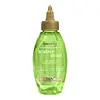What's inside
What's inside
 Key Ingredients
Key Ingredients

 Benefits
Benefits

 Concerns
Concerns

 Ingredients Side-by-side
Ingredients Side-by-side

Water
Skin ConditioningPropanediol
SolventGlycolipids
Skin ConditioningPEG-7 Glyceryl Cocoate
EmulsifyingHydroxyethyl Acrylate/Sodium Acryloyldimethyl Taurate Copolymer
Emulsion StabilisingQuaternium-80
Polysorbate 20
EmulsifyingZinc PCA
HumectantKaolin
AbrasiveMenthyl Nicotinate
HumectantGlycolic Acid
BufferingCocamidopropyl Dimethylamine
EmulsifyingPentylene Glycol
Skin ConditioningUrea
BufferingNiacinamide
SmoothingLinoleic Acid
CleansingLinolenic Acid
CleansingHamamelis Virginiana Water
AstringentSodium Lactate
BufferingSodium PCA
HumectantPanthenol
Skin ConditioningPropylene Glycol
HumectantSalicylic Acid
MaskingCI 77891
Cosmetic ColorantSodium Starch Octenylsuccinate
AbsorbentCalcium Pantothenate
Maltodextrin
AbsorbentSodium Benzoate
MaskingJasminum Sambac Flower Extract
MaskingPotassium Sorbate
PreservativeSodium Phytate
Sodium Ascorbyl Phosphate
AntioxidantRosa Damascena Flower Extract
MaskingTocopheryl Acetate
AntioxidantPyridoxine Hcl
Skin ConditioningAlcohol
AntimicrobialGlycine
BufferingFructose
HumectantInositol
HumectantLactic Acid
BufferingBisabolol
MaskingSilica
AbrasiveSynthetic Fluorphlogopite
Water, Propanediol, Glycolipids, PEG-7 Glyceryl Cocoate, Hydroxyethyl Acrylate/Sodium Acryloyldimethyl Taurate Copolymer, Quaternium-80, Polysorbate 20, Zinc PCA, Kaolin, Menthyl Nicotinate, Glycolic Acid, Cocamidopropyl Dimethylamine, Pentylene Glycol, Urea, Niacinamide, Linoleic Acid, Linolenic Acid, Hamamelis Virginiana Water, Sodium Lactate, Sodium PCA, Panthenol, Propylene Glycol, Salicylic Acid, CI 77891, Sodium Starch Octenylsuccinate, Calcium Pantothenate, Maltodextrin, Sodium Benzoate, Jasminum Sambac Flower Extract, Potassium Sorbate, Sodium Phytate, Sodium Ascorbyl Phosphate, Rosa Damascena Flower Extract, Tocopheryl Acetate, Pyridoxine Hcl, Alcohol, Glycine, Fructose, Inositol, Lactic Acid, Bisabolol, Silica, Synthetic Fluorphlogopite
Water
Skin ConditioningPolysorbate 20
EmulsifyingMelaleuca Alternifolia Leaf Oil
AntioxidantMentha Piperita Leaf Extract
Skin ConditioningHamamelis Virginiana Leaf Extract
Skin ConditioningMenthol
MaskingMenthyl Lactate
MaskingEthyltrimonium Chloride Methacrylate/Hydrolyzed Wheat Protein Copolymer
Polyquaternium-10
Cocamidopropyl Betaine
CleansingGlycerin
HumectantPropylene Glycol
HumectantSodium Hydroxide
BufferingCitric Acid
BufferingSodium Chloride
MaskingLactic Acid
BufferingPhenoxyethanol
PreservativeCaprylyl Glycol
EmollientParfum
MaskingWater, Polysorbate 20, Melaleuca Alternifolia Leaf Oil, Mentha Piperita Leaf Extract, Hamamelis Virginiana Leaf Extract, Menthol, Menthyl Lactate, Ethyltrimonium Chloride Methacrylate/Hydrolyzed Wheat Protein Copolymer, Polyquaternium-10, Cocamidopropyl Betaine, Glycerin, Propylene Glycol, Sodium Hydroxide, Citric Acid, Sodium Chloride, Lactic Acid, Phenoxyethanol, Caprylyl Glycol, Parfum
Ingredients Explained
These ingredients are found in both products.
Ingredients higher up in an ingredient list are typically present in a larger amount.
Lactic Acid is another well-loved alpha hydroxy acid (AHA). It is gentler than glycolic acid but still highly effective.
Its main role is to exfoliate the surface of the skin by loosening the “glue” that holds dead skin cells together. Shedding those old cells leads to smoother, softer, and more even-toned skin.
Because lactic acid molecules are larger than glycolic acid, they don’t penetrate as deeply. This means they’re less likely to sting or irritate, making it a great choice for beginners or those with sensitive skin.
Like glycolic acid, it can:
Lactic acid also acts as a humectant (like hyaluronic acid). It can draw water into the skin to improve hydration and also plays a role in the skin's natural moisturizing factor (NMF) in the form of sodium lactate.
Studies show it can boost ceramide production to strengthen the skin barrier and even help balance the skin’s microbiome.
To get results, choose products with a pH between 3-4.
Lower strengths (5-12%) focus on surface exfoliation; higher strengths (12% and up) can reach deeper in the dermis (deeper, supportive layer) to improve skin texture and firmness over time.
Though it was originally derived from milk, most modern lactic acid used in skincare is vegan. It is made through non-dairy fermentation to create a bio-identical and stable form suitable for all formulations.
When lactic acid shows up near the end of an ingredient list, it usually means the brand added just a tiny amount to adjust the product’s pH.
Legend has it that Cleopatra used to bathe in sour milk to help reduce wrinkles.
Lactic acid is truly a gentle multitasker: it exfoliates, hydrates, strengthens, and brightens. It's a great ingredient for giving your skin a smooth, glowing, and healthy look without the harshness of stronger acids.
Read more about some other popular AHA's here:
Learn more about Lactic AcidPolysorbate 20 is made by combining ethoxylation of sorbitan, ethylene oxide, and lauric acid. It is a mild cleansing agent, surfactant, and emulsifier.
As a surfactant, it helps collect dirt and oils for washing. Emulsifiers prevent oils and water from separating.
Polysorbate 20 also adds scent to a product. Since it is made using sorbitol, it has a sweet scent. Sorbitol can also be found in fruits such as apples and peaches.
The lauric acid used to create Polysorbate 20 is often derived from coconuts.
Polysorbate 20 may not be fungal acne safe.
Learn more about Polysorbate 20Propylene Glycol is an odorless, colorless liquid. As a humectant, it helps skin retain moisture. It also aids in delivering active ingredients.
Another role of this ingredient is preventing a product from melting or freezing. Propylene glycol also adds antimicrobrial properties to a product, elongating product lifespan.
This ingredient is considered an organic alcohol and commonly added into both cosmetics and foods.
Those with sensitive skin or conditions may develop a rash when using this ingredient.
Learn more about Propylene GlycolWater. It's the most common cosmetic ingredient of all. You'll usually see it at the top of ingredient lists, meaning that it makes up the largest part of the product.
So why is it so popular? Water most often acts as a solvent - this means that it helps dissolve other ingredients into the formulation.
You'll also recognize water as that liquid we all need to stay alive. If you see this, drink a glass of water. Stay hydrated!
Learn more about Water